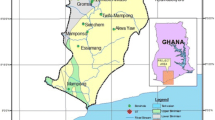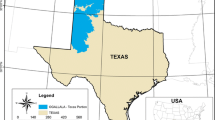Abstract
The springs of Jeju Island have been studied since 1999. However, previous studies did not provide a systematic analysis of survey results. Thus, we performed a systematic analysis of the groundwater flow system using cluster analysis of discharge variables, i.e., discharge rate, electrical conductivity (EC), and temperature, at 121 springs. The 121 springs were categorized into nine major groups based on discharge rates and ten groups based on EC. Springs in groups 1, 2, and 3 in discharge cases had peak discharge rates in September, October, and occasionally in November, following the rainy season. Other springs showed complex seasonal variation in discharge rates. Springs in groups 4–1, 4–3, 5–2, 9–1, and 9–2 had peak discharge rates in winter (December–February). The results of classification by EC were directly correlated with the absolute values of and seasonal variation in EC. Based on EC, springs in group 1 had relatively low EC of > 500 μS/cm in general. The highest EC at each spring in group 1 was 110–18,000 μS/cm. Coastal springs generally had higher EC than did springs located inland. The relation between discharge rate and EC was of interest. At some springs, discharge rate and EC were proportional, especially in winter. The proportionality between discharge and EC cannot be explained by the conventional groundwater management model of Jeju Island. To explain this proportionality, we examined the results of previous studies with regard to geological features, well locations, hydraulic head and hydraulic gradient distributions, and vertical reduction in groundwater EC within the zone influenced by saline water. We then proposed a hypothetical regional conceptual model of groundwater flow for Jeju Island. More precise studies are needed to clarify the relationships among responses at surveyed springs, hydraulic features in coastal areas, and the regional conceptual model for groundwater circulation on Jeju Island.
Similar content being viewed by others
References
Hildenbrand, A. Marlin, C. Conroy, A. Gillot, P.Y. Filly, A. and Massault, M. 2005, Isotopic approach of rainfall and groundwater circulation in the volcanic structure of Tahiti-Nui (French Polynesia). Journal of Hydrology, 302, 187, 208
Davis, G.H., Lee, Ch.K., Bradley, E. and Payne, B.R., 1970, Geohydrologic interpretations of a volcanic island from environmental isotopes. Water Resour. Res. 6, pp. 99–109.
Jeju Province, 1999, Spring; Water in Jeju.
Jeju Province, 2001, Comprehensive Investigation of Hydrogeology and Groundwater Resources for Jeju Island (I). Jeju Province.
Jeju Province, 2002, Comprehensive Investigation of Hydrogeology and Groundwater Resources for Jeju Island (II). Jeju Province.
Jeju Province and KOWACO, 2003, Comprehensive Investigation of Hydrogeology and Groundwater Resources in Jeju Island (III). Jeju Province.
KIGAM, 2004, Annual Report on Establishment of Sustainable Groundwater Supply System in Jeju Island. Korea Institute of Geoscience and Mineral Resources.
Kim, Y. Lee, K.S. Koh, D.C. Lee, D.H. Lee, S.G. Park, W.B. Koh, G.W. and Woo, N.C. 2003, Hydrogeochemical and isotopic evidence of groundwater salinization in a coastal aquifer: a case study in Jeju volcanic island, Korea. Journal of Hydrology, 270, 282–294.
Koh, D.C. Chang, H.W. Lee, K.S. Ko, K.S. Kim, Y. and Park, W.B., 2005, Hydrogeochemistry and environmental isotopes of ground water in Jeju volcanic island, Korea: implications for nitrate contamination. Hydrological Process, 19, 2225–2245.
Kovacs, A. Perrochet, P. Kiraly, L. and Jeannin, P.Y., 2005, A quantitative method for the characterisation of karst aquifers based on spring hydrograph analysis. Journal of Hydrology, 303, 152–164.
Larocque, M., Mangin, A., Razack, M., and Banton, O., 1998, Contribution of correlation and spectral analyses to the regional study of a large karst aquifer (Charente, France). Journal of Hydrology vol. 205, 217–231
Laudon, H., H. F. Hemond, R. Krouse, and K. H. Bishop, 2002, Oxygen 18 fractionation during snowmelt: Implications for spring flood hydrograph separation. Water Resour. Res., 38(11), 1258, doi: 10.1029/2002WR001510.
Lee, K.S. Wenner D.B. and Lee, I. 1999, Using H- and O-isotopic data for estimating the relative contributions of rainy and dry season precipitation to groundwater: example from Cheju Island, Korea. Journal of Hydrology, 222, 65–74.
Maoszewski, P. and Zuber, A. 1982, Determining the turnover time of groundwater systems with the aid of environmental tracers 1. Models and their applicability. Journal of Hydology, 57, 207–231
StatSoft, Inc., 2006, Electronic Statistics Textbook. Tulsa, OK: Stat- Soft. WEB: http://www.statsoft.com/textbook/stathome.html.
Winston, W.E., and R.E. Criss 2004, Dynamic hydrologic and geochemical response in a perennial karst spring. Water Resour. Res., 40, W05106, doi:10.1029/ 2004WR003054.
Author information
Authors and Affiliations
Corresponding author
Rights and permissions
About this article
Cite this article
Kim, T., Moon, DC., Park, WB. et al. Classification of springs of Jeju Island using cluster analysis of annual fluctuations in discharge variables: investigation of the regional groundwater system. Geosci J 11, 397–413 (2007). https://doi.org/10.1007/BF02857055
Received:
Accepted:
Issue Date:
DOI: https://doi.org/10.1007/BF02857055




